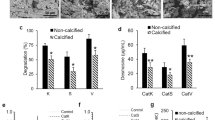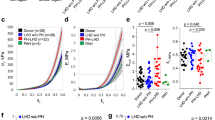Summary
A neonatal rat aorta smooth muscle cell culture system with a unique elastin-rich extracellular matrix was used as a model substrate for elastases. To study the susceptibility to solubilization of insoluble elastin, cultures were incubated in the presence of human neutrophil elastase (HNE) or porcine pancreatic elastase (PPE) and in the absence of serum for periods up to 45 min. Both the incubation media and cell layers were then assessed for elastin and collagen markers, total protein, and lactate dehydrogenase (LDH). Although HNE and PPE exhibited comparable activity against elastin purified from the cell layer, HNE exhibited a 6.7- to 25-fold reduction in its elastin solubilizing activity using intact cell layers as compared with the purified elastin, whereas PPE exhibited only a 1.5- to 2.5-fold reduction. This effect could not satisfactorily be explained as preferential inhibition of HNE activity in the culture system, because the amount of protein solubilized by HNE was 59% that of PPE. The mean elastin content of PPE-solubilized protein was 110% that of the elastin content of the corresponding cell layer; the value for HNE-solubilized protein was only 16%. Thus, the amount of elastin per microgram of solubilized protein for HNE was 15% that for PPE. Possible explanations for the greatly diminished elastolytic activity of HNE in the culture system include the preference of HNE for other substrates in the cell layer, the inability of HNE to penetrate sufficiently into the cell layer, and the presence of sulfated glycosaminoglycans in the vicinity of the elastin that act in an inhibitory fashion. Although there was extensive proteolytic damage to the extracellular matrix, LDH and DNA measurements indicated that little loss of cells or cell viability occurred. The observed differences in elastolytic activity of HNE and PPE in the culture system parallel the relative emphysema-inducing potency of the elastases in the hamster model of elastase-induced emphysema.
Similar content being viewed by others
References
Andrews, J. L.; Ghosh, P.; Lentini, A., et al. The interaction of pentosan polysulphate (SP54) with human neutrophil elastase and connective tissue matrix components. Chem. Biol. Interact. 47:157–173; 1983.
Baici, A.; Bradamante, P. Interaction between human leukocyte elastase and chondroitin sulfate. Chem. Biol. Interact. 51:1–11; 1984.
Barile, M. F.; Kern, J. Isolation of Mycoplasma arginini from commercial bovine sera and its implication in contaminated cell cultures. Proc. Soc. Exp. Biol. Med. 138:432–437; 1971.
Barone, L. M.; Faris, B.; Chipman, S. D., et al. Alteration of the extracellular matrix of smooth muscle cells by ascorbate treatment. Biochim. Biophys. Acta. 840:245–254; 1985.
Birkedal-Hansen, H.; Taylor, R. E.; Bhown, A. S., et al. Cleavage of bovine skin type III collagen by proteolytic enzymes. Relative resistance of the fibrillar form. J. Biol. Chem. 260:16411–16417; 1985.
Blondin, J.; Janoff, A. The role of lysosomal elastase in the digestion ofEscherichia coli proteins by human polymorphonuclear leukocytes. Experiments with living leukocytes. J. Clin. Invest. 56:971–979; 1976.
Burton, K. A study of the conditions and mechanism of the diphenylamine reaction for the colorimetric estimation of deoxyribonucleic acid. Biochem. J. 62:315–323; 1956.
Dubick, M. A.; Rucker, R. R.; Cross, C. E., et al. Elastin metabolism in rodent lung. Biochim. Biophys. Acta. 672:303–306; 1981.
Dunn, D. M.; Franzblau, C. Effects of ascorbate on insoluble elastin accumulation and cross-link formation in rabbit pulmonary artery smooth muscle cultures. Biochemistry 21:4195–4202; 1982.
Faris, B.; Moscaritolo, R.; Levine, A., et al. Isolation of purified insoluble aortic collagen. Biochim. Biophys. Acta. 534:64–72; 1978.
Faris, B.; Toselli, P.; Kispert, J., et al. Elastase effect on the extracellular matrix of rat aortic smooth muscle cells in culture. Exp. Mol. Pathol. 45:105–117; 1986.
Foster, J. A.; Bruenger, E.; Rubin, L., et al. Circular dichroism studies of an elastin crosslinked peptide. Biopolymers 15:833–841; 1976.
Jones, P. A.; Werb, Z. Degradation of connective tissue matrices by macrophages. Influence of matrix composition on proteolysis of glycoproteins, elastin, and collagen by macrophages in culture. J. Exp. Med. 152:1527–1536; 1980.
Kagan, H. M.; Jordan, R. E.; Lerch, R. E., et al. Factors affecting the proteolytic degradation of elastin. Adv. Exp. Med. Biol. 79:189–207; 1977.
Karlinsky, J. B.; Snider, G. L. Animal models of emphysema. Am. Rev. Respir. Dis. 117:1109–1133; 1978.
Kramsch, D. M.; Hollander, W.; Franzblau, C. The role of arterial elastin in the lipid accumulation in human atherosclerotic arteries. In: Jones, R. J., ed. Atheroslerosis. Second International Symposium. New York: Springer-Verlag; 1969:15.
Kuhn, C., III; Slodkowska, J.; Smith, T., et al. The tissue response to exogenous elastase. Bull. Eur. Physiopath. Respir. 16(suppl.):127–137; 1980.
Lansing, A. I.; Rosenthal, T. B.; Alex, M., et al. The structure and characterization of elastic fibers as revealed by elastase and by electron microscopy. Anat. Rec. 114:555–570; 1952.
Mainardi, C. L.; Dixit, S. N.; Kang, A. H. Degradation of type IV (basement membrane) collagen by a proteinase isolated from human polymorphonuclear leukocyte granules. J. Biol. Chem. 255:5435–5441; 1980.
Mainardi, C. L.; Hasty, D. L.; Seyer, J. M., et al. Specific cleavage of human type III collagen by human polymorphonuclear leukocyte elastase. J. Biol. Chem. 255:12006–12010; 1980.
McMahon, M. P.; Faris, B.; Wolfe, B. L., et al. Aging effects on the elastin composition in the extracellular matrix of cultured rat aortic smooth muscle cells. In Vitro 21:674–680; 1985.
Morris, S. M.; Stone, P. J.; Rosenkrans, W. A., et al. Palladium chloride as a stain for elastin at the ultrastructural level. J. Histochem. Cytochem. 26:635–644; 1978.
Oakes, B. W.; Batty, A. C.; Handley, C. J., et al. The synthesis of elastin, collagen, and glycosaminoglycans by high density primary cultures of neonatal rat aortic smooth muscle. An ultrastructural and biochemical study. Eur. J. Cell Biol. 27:34–46; 1982.
Partridge, S. M.; Davis, H. F.; Adair, G. S. The chemistry of connective tissue. 2. Soluble proteins derived from partial hydrolysis of elastin. Biochem. J. 61:11–21; 1955.
Peterkofsky, B.; Diegelmann, R. Use of a mixture of proteinase-free collagenases for the specific assay of radioactive collagen in the presence of other proteins. Biochemistry 10:988–994; 1971.
Reilly, C. F.; Travis, J. The degradation of human lung elastin by neutrophil proteinases. Biochim. Biophys. Acta 621:147–157; 1980.
Senior, R. M.; Tegner, H.; Kuhn, C., et al. The induction of pulmonary emphysema with human leukocyte elastase. Am. Rev. Respir. Dis. 116:469–475; 1977.
Snider, G. L.; Lucey, E. C.; Christensen, T. G., et al. Emphysema and bronchial secretory cell metaplasia induced in hamsters by human neutrophil products. Am. Rev. Respir. Dis. 129:155–160; 1984.
Starcher, B. C. Determination of the elastin content of tissues by measuring desmosine and isodesmosine. Anal. Biochem. 79:11–15; 1977.
Starcher, B. C.; Galione, M. J. Purification and comparison of elastins from different animal species. Anal. Biochem. 74:441–447; 1976.
Stone, P. J. The elastase-antielastase hypothesis of the pathogenesis of emphysema. Clin. Chest Med. 4:405–412; 1983.
Stone, P. J.; Calore, J. D.; McGowan, S. E., et al. Functional alpha-1-protease inhibitor in the lower respiratory tract of cigarette smokers is not decreased. Science 221:1187–1189; 1983.
Stone, P. J.; Calore, J. D.; Snider, G. L., et al. The dose dependent fate of enzymatically active and inactivated tritiated methylated pancreatic elastase administered intratracheally in the hamster. Am. Rev. Respir. Dis. 120:577–587; 1979.
Stone, P. J.; Franzblau, C.; Kagan, H. M. Proteolysis of insoluble elastin. Methods Enzymol. 82A:588–605; 1982.
Werb, Z.; Banda, M. J.; Jones, P. A. Degradation of connective tissue matrices by macrophages. I. Proteolysis of elastin, glycoproteins, and collagen by proteinases isolated from macrophages. J Exp. Med. 152:1340–1357; 1980.
Worthington Enzymes. Feehold. NJ: Worthington Biochemicals Inc., 1978:111–112.
Worthington Enzymes. Freehold, NJ: Worthington Biochemicals Inc., 1978:196–197.
Author information
Authors and Affiliations
Rights and permissions
About this article
Cite this article
Stone, P.J., McMahon, M.P., Morris, S.M. et al. Elastin in a neonatal rat smooth muscle cell culture has greatly decreased susceptibility to proteolysis by human neutrophil elastase. An in vitro model of elastolytic injury. In Vitro Cell Dev Biol 23, 663–676 (1987). https://doi.org/10.1007/BF02620979
Received:
Accepted:
Issue Date:
DOI: https://doi.org/10.1007/BF02620979




